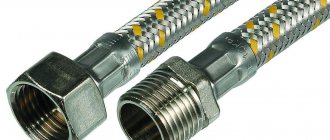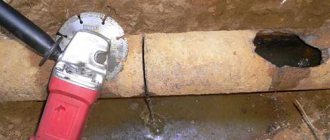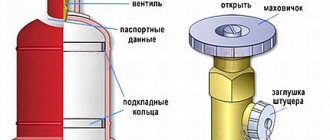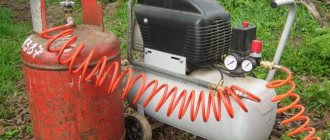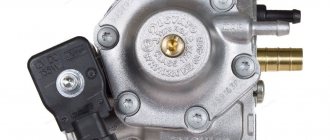“What is the maximum length of the gas hose?” - This is the question asked by those consumers whose gas-consuming equipment (stove, water heater, boiler, etc.) is located at a distance of several meters from a stationary metal pipe (riser). The Internet contains a lot of conflicting information on this matter. For obvious reasons, gas service employees “like” to limit the maximum length of the gas hose, in particular, to two meters, since it is more profitable for them to impose on the consumer an expensive paid service for lengthening the rigid metal main intra-apartment (or intra-house) pipe. At best, this parameter (permissible length) is fixed in the internal instructions of gas industry organizations, which in the recent past were monopolists in their service territories. But now the situation has changed. Currently, in connection with the development of the institution of ownership of apartments and private houses, and the emergence of the resulting rights and obligations among the owners, the area of responsibility of such organizations ends with the tap installed on the riser (pipe) in your apartment or house. The above-mentioned instructions are internal documents that the employees of these organizations themselves must comply with, and these instructions cannot in any way be attributed to federal legislation, which, as is known, is dominant throughout the entire territory of the Russian Federation. According to the European standard (European safety standards EN), the maximum length of a gas hose , for example, for connecting a stove, is indeed limited to two meters. As for the Russian Federation, we do not have such a restriction. According to SNiP (Building Norms and Rules) 42-01-2002 dated 03/01/2005. “Gas distribution systems”, adopted and put into effect by Resolution of the Gosstroy of Russia No. 163 dated December 23, 2002, date of implementation July 1, 2003 (see clause 7.3 of Section 7 “Internal gas pipelines” of the specified SNIP): “Internal gas pipelines should be made from metal pipes. The connection to them of household gas appliances, instrumentation, LPG cylinders, gas burners of portable and mobile gas-using equipment may be provided with flexible hoses that are resistant to the transported gas at a given pressure and temperature.” That's all. No word on the maximum allowed length. Those interested can familiarize themselves with the full text of this document on our website HERE .
When approaching renovations in a kitchen where there is a gas stove, one of the first questions that needs to be resolved is what to do with the gas distribution? I would like, for example, to rearrange the stove or, as an option, install a separate hob and oven. Do I need to make a gas supply from welding pipes for this, or can I use a flexible hose? What can be its maximum length? We are publishing explanations from a specialist from MOSGAZ OJSC on this topic.
How long can a flexible hose be for connecting a gas stove (oven and hob)?
Question: Good afternoon. I have a question: what is the maximum length of a flexible hose for connecting a gas stove, which ones can be used? Thank you.
Answer: Dear Lyudmila Valerievna! In response to your request dated February 18, 2016, MOSGAZ OJSC reports the following.
According to clause 3.21 of the Moscow standard for the operation of the housing stock ZHM-2004/03 “Gas pipelines and gas equipment of residential buildings”, approved and put into effect by Decree of the Moscow Government dated November 2, 2004 No. 758-PP, connecting gas appliances to the gas pipeline is allowed through a flexible connection, having no butt joints and having a heat resistance of at least 120 degrees.
Flexible liner should be:
- accessible for inspection and maintenance;
- should not be pinched by anything, have kinks or experience tensile forces;
- It is not allowed to lay it in places where it may be susceptible to corrosion, namely behind a sink, in places where it is possible to be washed by combustion products or come into contact with heated metal.
The length of the flexible line depends on the installation location of the disconnecting device. The shut-off valve is installed on a horizontal section of the gas pipeline, at a distance of at least 20 cm from the side of the stove. For overhead wiring, the shut-off valve should be installed on the descent to the slab at a height of 1.5 -1.6 m from the floor.
Service staff can offer installation of flexible hoses up to 3.0 meters in length.
Bellows hose for gas, advantages
- The gas hose is manufactured in accordance with technical specifications and satisfies GOST regulations;
- The only one approved for use by government services;
- Component PVC coating provides the product with reliable protection. Polymers are highly resistant to aggressive environments and mechanical shocks.
- The gas supply line often remains undamaged, subjected to significant and sometimes critical loads;
- Manufacturers set a long service life for the product, more than 25 years;
- PVC protects against electrical influences of 1000 V or more.
- There are no regulations regarding restrictions during operation.
Features of choosing the best hose
It is advisable to purchase hoses for supplying gas to household equipment in specialized stores that can provide a quality certificate for each product.
The range includes models of different lengths. It is selected so that in the future you do not have to connect several tubes to each other.
The most commonly used tubes are 1, 1.5 and 2 meters. This reduces the risk of line ruptures and, accordingly, increased danger for apartment residents. If the length is not enough, the supply is supplemented with a metal pipe.
Another important indicator is the cross-section diameter. The minimum value that will ensure good cross-country ability and full gas supply to the device is 10 mm.
The ends of the hoses are equipped with two nuts or one nut and a fitting. The nut has an internal thread, the fitting has an external thread. The thread is selected in accordance with the outlet on the household appliance. If the outlet is direct, then a special fitting-angle is used.
Professionals advise buying hoses with sufficient length (sleeves up to 4.5 meters are available for sale). This approach will allow you to choose any convenient place for the equipment and simplify installation, freely performing the installation without excessive tension
An ordinary rubber-fabric hose will do as a budget option. When choosing this product, you need to carefully monitor the degree of wear.
If the slightest cracks, damage or smell of gas is detected, replace it in a timely manner. When looking for an offer that would optimally combine price and quality indicators, it makes sense to focus on reinforced hoses.
In order for the gas to reach all burners on the stove in the required volume, the diameter of the gas hose must be at least 10 mm. The bigger it is, the better
If finances allow, it is better to take a bellows hose. It is recognized as the safest and most reliable device - officially approved for use with household appliances by city gas services.
When choosing it, you need to check the type of connection. Its quality directly affects the durability of the product. It is not advisable to take models in which the fitting is connected to the corrugation using glue. It is more advisable to find a solid or welded structure.
Reinforced gas hose.
The most common are rubber reinforced hoses that look like hoses for water supply.
On the outside they are braided with steel threads. Although they are called rubber, they contain a polymer material inside. The easiest way to distinguish a gas hose from a water hose is by the color of the threads woven into the outer braid; they should be yellow. Metal braided hoses are inexpensive and easy to use, but some European countries have banned their use
In our country, gas workers also recommend gradually abandoning them or using them with precautions.
The plastic hose inside is subject to the same destruction and destruction as rubber. In addition, steel is a good conductor of electric current, so the connection must be made with the mandatory use of dielectric gaskets.
Classification of classes, parameters and sizes of oxygen hoses
Currently, 2 classes of special products are produced, in the form of a simple sleeve or as a multifunctional cable complete with a gas burner. The latter are universal in purpose and are equipped with: a hose with a built-in welding gun-torch and a special connecting connector. This kit is suitable for a semi-automatic process that requires the wire to be fed to the processing site along a guide channel with a compressed spiral. The inner surface of which is usually strengthened to protect the structure with a special tube made of wear-resistant materials, such as Teflon.
In addition to the traditional single-channel transmission method, the hoses can also operate according to the parallel supply principle. In this case, several channels are placed simultaneously in one coaxial cable. The permissible length of welding hoses is from 8.0 to 20.0 m; it is prohibited to use hoses shorter than 9.0 and longer than 30.0 meters during work. Certain tolerances for increasing the length are allowed for large slip structures up to 40 m, and above 40 m, a special permit for work will be required in the presence of the person responsible for safety.
It is permissible to lengthen the sleeves with nipples made of steel or brass, while in order to avoid breakdown and leaks, the sleeves with nipples are additionally secured with soft types of wire. The length of the connecting sections cannot be less than 3 m. It is prohibited to use smooth-bore tubes to connect structures.
Before connecting the hoses with the cutter, they must be purged with working media: oxygen, respectively, O2, and propane, with propane. During the welding process, it is prohibited to pull the hoses or step on their sections and place them near an open fire or a high-temperature source. They must also be protected from sparks. Upon completion of the process, the hoses are carefully collected onto the reel and placed on fastenings or placed in a place specially prepared for storage.
Connecting the gas hose to the stove
After purchasing a suitable product option, we eagerly move on to the steps of connecting the hose to the new stove. We find a fitting at the back of the plate, usually with an external thread. This is the gas supply inlet. Slab manufacturers complete their products with a straight or angular receiver, depending on the model.
If you get a device with a direct entrance, we recommend purchasing a brass corner with internal threads and a boundary wall into which a paranitic gasket is inserted. When installing, avoid sharp bends in the hose.
Imported slabs are sometimes sold with 3/8 or 3/4 inch threads at the outlet. There will be no tragedy if you additionally purchase a regular “futorka” adapter for the commensurate threads of your gas hose in advance. In residential buildings, the gas riser is usually installed in one of the corners of the kitchen area. There is an outlet from it for your use; a gas tap must be installed on it. We will screw or screw our gas hose onto it, depending on what thread the valve is equipped with.
As standard, the gas hose comes with two paronite gaskets. Remember to use them when connecting, this will make it easier for you to ensure that there are no leaks. They also advise using a gasket purchased separately with a fine mesh; experts claim that it will help get rid of various types of contaminants. But we leave this procedure at your discretion, since gas usually flows without mechanical inclusions.
The gas hose is screwed on with a wrench, but do not overdo it and do not squeeze out the paronite. After the work has been completed, it remains necessary to carry out a mandatory check for possible gas leaks. It is enough to apply soap suds to the connections; the absence of air bubbles indicates that the work was done efficiently and the stove can be used. Bon appetit!
Maintaining Basic Safety
- The main requirement of the gas service is access to the supply line, so the flexible hose for the gas stove must be within reach;
- It is not allowed to have third-party connections to the gas stove;
- The gas hose must be kept clean, embellishment is not allowed, it cannot be coated with paint, or other “improvements” in appearance are made;
- The eyeliner should have a natural sag. Tension is fraught with a break in the hose, or gas leakage at the points of connection to the fittings;
- If you plan to move the stove before general cleaning, calculate the required length of the gas hose in advance. Be sure to close the ball valve before moving;
- Avoid excessive bending or twisting;
- It is necessary to protect the metal braid from condensation;
- Do not weld or solder the connection, use only the threaded joining method;
- Replace the old gas hose with a new one in a timely manner, in accordance with the service life established by the manufacturer.
We really hope that our review helped you decide and understand which gas hose for a gas stove is best to choose. Now you definitely won’t get lost in the store, since you have learned the specific features and differences between gas hoses. Self-connection will also not take much time if you have the necessary tools.
However, please note that a number of manufacturers do not allow the owner of the equipment to perform such work. One of the requirements is increasingly becoming the condition for connecting devices by specialists of an authorized gas service
Otherwise, there is a risk of losing the warranty. Check the operating instructions to see if you will lose the warranty on the stove if you connect it yourself. If not, we wish you good luck!
We offer you an entertaining video review, where channel 1 recommends which gas hose is best to use at home:
What is a bellows gas line
A bellows connection is a thin-walled corrugated stainless steel hose equipped on both sides with threaded pipes for attachment to the pipeline and fittings of gas equipment.
Typically, AISI 316 stainless steel with a thickness of 0.2 - 0.3 mm is used for hoses; AISI 303 or AISI 304 stainless steel, nickel-plated brass CW617N and chrome-plated carbon steel are used for nuts and fittings.
Hose fittings can have external or internal threads, which are threaded on a union nut and held on the end of the hose with a protruding rim. This type of connection together with the ring gasket is called American.
The manufactured models have pipes with two American female threads or with external threads in combination with a union nut.
Bellows hoses are produced in different lengths; in their passport data, in addition to the type of threaded pipes (BP, V, G - internal thread, nut or HP, N - external thread), they indicate the diameter in inches.
The standard thread size for connecting pipes is 1/2 inch (12.7 mm); products with 3/4 inch (18 mm) are less common.
The ring gasket is mainly made of hard and durable paronite. Thanks to this sealing material, it is possible to achieve a high degree of sealing due to the application of greater physical force when tightening the nut.
Some sleeve models are produced in a yellow polymer shell. This simplifies the care of products and increases their strength parameters.
Rice. 2 Design of bellows and their configuration
How to properly connect a gas boiler to the water supply system
Gas heating scheme.
The connection diagram for a gas heating boiler implies a mandatory connection to the system
water supply The work at this stage is similar to connecting to a heating circuit. This step will require the use of these materials and tools:
- cleaning filter;
- American taps;
- spanners;
- sealant.
The cold water supply must be equipped with a special cleaning filter to prevent all kinds of contaminants from entering the device itself. Taps used to shut off access to the water supply must have detachable connections. Such cranes are called “American cranes”. The cold water pipes here are located on the left, and the hot water pipes on the right.
Connecting a gas stove with a flexible hose requirements
Fafhrd, now SNiP seems to be in charge and something like this: 7. The use of copper and multilayer metal-polymer pipes is allowed for gas pipelines with pressure of category IV. Multilayer metal-polymer pipes may be used for internal gas pipelines when supplying natural gas to residential single-apartment buildings with a height of no more than three floors, provided that their suitability for use in construction is confirmed in the prescribed manner. It is allowed to connect household gas appliances, instrumentation, LPG cylinders, gas-burning devices of portable and mobile gas-using equipment to gas pipelines with flexible hoses that are resistant to the transported gas at a given pressure and temperature, including heat-resistant flexible multilayer polymer pipes reinforced with synthetic threads, subject to confirmation in the established procedure for their suitability for use in construction.
Installation of a gas appliance
When purchasing a device, check the availability of a certificate and compliance of the fasteners with the parameters of your system. The technical data indicated on it must correspond to the passport data.
Installing the machine on the floor
Floor-standing boilers are quite heavy, so the floor must be durable with a fireproof coating. For the floor, you can use concrete blocks or fireproof slabs. Concrete blocks are selected with a thickness of at least 10 cm and sheathed with metal on top. The device is installed at a distance of 1 cm from the walls. The perimeter walls near the boiler are covered with non-flammable materials. The casing should be 10 cm above the device itself.
The device must be level on the floor. It is allowed to place non-combustible materials under the legs. The chimney pipe and the heating system pipeline are connected to the boiler. Indoors, the length of the chimney should not exceed 5 m, the pipe diameter should be at least 110 cm. It is recommended to install a filter for coarse water before entering the return and water supply boiler. The heat exchanger will not become heavily clogged. Gas connection is carried out only by the gas service.
Connecting a wall-mounted boiler
The wall on which the wall-mounted apparatus will be hung must be strong and level. It is recommended to install a 3 mm thick non-flammable gasket on the wall under the device. If the wall consists of flammable materials, the boiler is moved 4.5 cm away from the wall. The distance from other devices and equipment is maintained at least 20 cm. There should be a source of electricity nearby to connect the device.
The device is mounted on slats to the wall at a height of 0.8-1.6 m from the floor. The device must be installed strictly horizontally, otherwise it will not work correctly. Remove the plugs from the pipes and connect the boiler to the water supply. It is recommended to install a coarse filter at the inlet of the water supply and return to the device.
The gas pipeline is connected only by the gas service through a metal pipe with a metal coupling or through a special connection. It is necessary to check the tightness of the supply. A metal or other fireproof sheet 1x1 m is laid on the floor above the boiler. Asbestos-cement sheets are unsuitable for this purpose; the gas service does not allow their use.
If the device has its own deaeration system and a built-in expansion tank, it is necessary to remove the old tank from the system and close the connection point (air valve) tightly, checking for leaks. Otherwise, there will be a high probability of explosion due to air leaks.
Secure Connection Instructions
If you have at least minimal skills, you can connect the gas to the device yourself.
When working, you must adhere to the following rules:
- select the length of the line taking into account the distance over which the equipment will presumably move;
- place the device in a place accessible for visual inspection, without hiding it under the floor or in the wall;
- make sure that there are no other connections on the device (the exception is the wire that functions as a backlight in the oven);
- do not paint the product, as this leads to rapid cracking of the material;
- use gas hoses of standard sizes, provided for by the standards established by GOST;
- do not provoke electrolytic damage by connecting copper tips with steel ones (safe combinations: steel-steel, brass-copper);
- avoid twisting, bending and stretching of the sleeve;
- Do not expose connections to high temperatures (soldering, welding).
In multi-storey buildings, a common gas riser is installed, which has branches with taps at the ends. They are present in every apartment and are called omission.
Connecting gas to the stove is not difficult: all you need is a little free time and a minimal set of tools
At the first stage of work, the room is prepared and the gas supply to the network is shut off. Then the equipment, be it a column or a slab, is placed at the installation site and carefully leveled.
After this, you need to apply a seal to the hose fitting and screw it into the tap on the lower side. If the thread on the device does not match the diameter of the sleeve, you will need an adapter, which also seals. Next, the hose is connected to the equipment.
To connect you will need a flexible hose itself, a ball valve, a seal (Fum tape, Loctite), a screwdriver, an adjustable wrench, as well as a soap solution (water + soap or gel) and a brush
At the end, the tightness of the connecting elements is tested by opening the tap. This can be easily done using ordinary soap emulsion and a small brush.
If the connection is not tight, the applied soap solution will foam and bubble, but if everything is in order, no reaction will occur
If insufficient connection density is detected, the tap handle is lightly screwed together and the winding is checked. The last step is to diagnose the functionality of the equipment and gas supply.
The best solution if you lack confidence in your own abilities is to turn to gas workers. Our specialists will carry out the connection in compliance with all standards, which will guarantee that the system will function properly, safely and reliably for many years.
Our website has detailed instructions on how to replace a gas hose and how to connect various gas equipment.
We invite you to familiarize yourself with these materials:
- Replacing a gas hose with your own hands: rules for installation work
- How to move a gas pipe in an apartment: transfer rules and location tips
- Connecting a gas stove with your own hands: how to install a gas stove in an apartment step by step
- Connection diagram for a double-circuit gas boiler: how to properly supply gas to the boiler
- Installing a geyser in an apartment with your own hands: requirements and technical standards for installation
Varieties
Flexible gas supply can be represented by three different types in terms of quality, price and material of manufacture. The division into types is carried out according to the material of manufacture. So, the sleeve can be:
- Rubber, that is, made of rubber, additionally reinforced with thread;
- Made of steel - rubber, which has a metal braid, usually made of stainless steel;
- Bellows.
Description of rubber products
The rubber tube is made of rubber, which is completely reinforced with nylon thread. Hoses are usually sold with lengths from 1.2 to 4.
Generally speaking, rubber fabric eyeliners are the softest of all three presented. This quality can be called a disadvantage, since there is no safety margin.
The technical specifications are as follows:
- Manufactured according to the requirements of TU 23.05765871.01-92 (of course, this is for those materials that are domestic);
- Capable of withstanding pressure up to 0.05 MPa;
- Retains its properties and works normally in the temperature range from -10 to +70 degrees Celsius. It should be noted here that this is the temperature range that does not have any effect on the rubber at all. Rubber liners can work normally even at -50, but at this temperature the rubber becomes less flexible and can easily tear, or rather crack;
- Has connection dimensions G1/2”.
As for installation and maintenance, there is nothing complicated, there are only a few recommendations:
- The hose should not be in the area of the fan blowing (with hot air), in direct contact with gas appliances (of course, except for the connection point) or near the oven;
- The tightness of the connection is achieved using special paronite gaskets;
- During use, the sleeve should not be stretched or bent at very sharp angles;
- The service life ranges from 7 to 10 years depending on operating conditions.
Stainless steel
Flexible gas lines made of steel are very common today. It is represented by a tube that has a stainless steel braid. The braid has a yellow stripe. In appearance, such tubes are very similar to water products, which instead of a yellow stripe have red and blue.
At the ends of the hose there are two fittings, which, like the braid, are made of stainless steel. The fittings are inserted into the mounting points and secured with special union nuts. In this case, the tightness of the connection is achieved using special washers made of soft metals such as copper and aluminum.
Conditions for normal operation are those under which normal temperature conditions are maintained (the same as for rubber products), there are no kinks or breaks in the hose, and it has no tension.
One of the advantages of such a stainless steel liner is that it is very cheap, while being much stronger and more rigid in relation to rubber-fabric products.
Bellows liner
One of the most expensive and most reliable eyeliners. It is made in the form of a corrugated metal pipe. There are two fittings at the ends, which are secured using union nuts and sealing washers.
Capable of withstanding pressure up to 6 atmospheric units, while the normal pressure in the gas supply system is considered to be 0.03 atmospheres.
The operating temperature range is from -50 to +250 degrees. Since the bellows is, in fact, corrugated, it is not afraid of stretching. In addition, the bellows hose is capable of stretching up to 3.5 times. A normal stretch is considered to be an increase of 50-70 percent.
The bellows liner has a bright yellow color, and the union nuts and fittings have the natural color of stainless steel.
As for the scope of application, there is only one - connecting the consumer to the gas supply system.
Installation is carried out through a special insert - dielectric. Its purpose is to prevent the spread of electric current through the hose if a breakdown occurs. This insert is mounted between the consumer and the hose.
Characteristics
The bellows connection for gas 1/2 has the following operational and physical parameters:
- Withstands pressure in the line from 6 to 11 bar (depending on the wall thickness), which is 200 - 400 times more than the nominal gas pressure in the network of communal and private houses, which is 0.03 bar.
- Standard hoses are designed for ambient temperatures from -50 to +130 °C. Stainless steel itself can withstand temperature loads up to + 200 °C, that is, theoretically it can remain in the flame of a gas burner for some time without any damage.
- Diameters of a typical corrugated bellows sleeve: internal 12.4 mm, external 17.1 mm.
- The bending radius of the hose along the inner shell is at least 35 mm.
- The service life of bellows-type liners is at least 10 years, in practice it can reach up to 30 years. Reliability, durability and tightness of the connection of the corrugated pipeline with fittings is ensured by their argon-arc welding in an inert gas environment.
Rice. 3 Physical and operational characteristics of La Flex gas connections
Related article:
Bellows water line: basic parameters, selection and connection . The article describes in detail what a bellows liner for water is, what types there are, where they are used, and technical characteristics. Read it, it might be interesting.
Stainless steel bellows type gas hose.
Bellows-type hoses are the only ones approved by gas services for household gas appliances. What is a bellows? This is a corrugated, durable and dense shell that retains its properties when exposed to temperature, pressure and severe mechanical load.
The bellows takes its name from the English. branded Sylphon. It comes in single- and multi-layer types, and is made from both metallic and non-metallic materials. The shell serves as a barrier and gives the product increased safety.
Bellows flexible hoses are made of stainless steel. They come in two types. The first in a metal braid without insulation, this type is suitable for ordinary stoves with traditional ignition from matches. If your modern gas stove is equipped with electric ignition and is connected to the electrical network, then you should not bother looking for a dielectric gasket.
It is easier to turn your attention to the second type with a yellow polymer coating, which is reliable electrical insulation. This type of protection is especially relevant for gas stoves equipped with various electrical components - electric ignition, lighting, electric grill. The polymer coating is durable, strong, reliable and guarantees absolute electrical insulation.
For uniform gas supply, an internal hose diameter of at least 10 mm is recommended. The advantages of using bellows hoses are undeniable. Samples with a plastic coating, which guarantee excellent protection from various disasters, have proven themselves especially well.
Bellows hoses have a service life of up to 30 years. Their only drawback is their high cost compared to other types of gas hoses, but here, as they say, safety is more expensive! Moreover, the increased cost as a percentage will be negligible compared to purchased gas equipment.
Types of gas flexible hoses
The current market offers a fairly extensive list of gas hoses. In addition to the material, you will also need to choose a manufacturer. And in this case it is better not to save. The item is bought once and for a long time. Having saved 500 rubles, you can then spend a lot on health and repairs if the pipe starts leaking gas. Therefore, let’s first look at the varieties.
Rubber-fabric
It has many advantages that allow it to be used in a gas system:
- easy installation;
- good flexibility;
- low cost;
- various sizes;
- excellent electrical insulation.
The disadvantage of such rubber parts is poor rigidity. Today, the industry produces hoses from a special material of high elasticity. Therefore, their service life can reach 10 years.
The cost of such hoses usually does not exceed $7.
Bellows metal
Professional gas fitters consider it the most suitable for gas systems. The service life of such hoses can be more than 25 years. It connects to a gas stove without any difficulty. Bellows systems can be connected to boilers and water heaters, and they are completely safe.
If you have a gas stove equipped with electric ignition in your kitchen, in order to connect the bellows device, a special insulating connection is created between it and the tap.
This type of hose bends freely and can withstand high pressure, reaching 6 atmospheres. It can withstand significant temperature changes ranging from -50 degrees to heating up to 200 degrees. The main disadvantage of a bellows hose is its cost. It is many times higher than similar gas connections.
The advantages of such bellows metal systems include:
- made of stainless steel;
- complies with GOST;
- meets all technical requirements;
- protected from any mechanical influences by a special polymer coating;
- able to withstand any mechanical impact;
- the warranty period exceeds 30 years;
- withstands voltage of 1500 Volts.
Oxygen
It can also be connected to gas stoves, but you need to take into account several very important points:
- The internal diameter must exceed 16 millimeters;
- The surface in contact with oxygen must be well cleaned of oil. Otherwise, the hose will overheat and material damage will occur.
The advantages of oxygen hoses include the following characteristics:
- withstands high pressure. It can reach 20 atmospheres;
- very simple installation;
- low cost;
- rich assortment;
- does not conduct electric current.
Rubber gas hose.
The softest of all types of hoses are rubber hoses reinforced with textile thread. They have long gained a reputation as an unpretentious compound, and are often found in the household of a thrifty homeowner. Simple installation work, low cost, flexible properties and functionality are attractive qualities that determine popularity. There are always options on the shelves with different lengths and diameters.
Rubber is one of the best dielectric materials. They are used to supply liquefied gas from gas cylinders to household appliances and are used in dachas and private homes. This method of flexible gas supply is the simplest and cheapest, but also the most dangerous.
The big disadvantage is that over time, cracks form in the rubber, leading to gas leakage. The only place where it is permissible to use this type of flexible connection is gas cylinders in the private sector. Among other things, the products lack the necessary rigidity.
It is not recommended to use rubber fabric sleeves for more than two years, but in practice they last much longer. However, modern rubber hoses are made with elastic components that allow the product to be used for up to 5 years.
With metal braid
It has an optimal ratio of price, quality and durability. Price from 140 rubles per 60 cm of finished product. The hose is made of vulcanized rubber and reinforced with textile thread. The outer part is a metal braid.
One of the most common options, the popularity of which is associated with many positive qualities, including:
- high level of reliability;
- ease of installation;
- longer service life compared to rubber products;
- large selection of lengths and diameters;
- permissible temperature has a wide range from -35 to + 50 degrees;
- ease of use.
Gas services often recommend replacing old metal-braided hoses due to the inability to check the condition of the rubber under the braid. If it is impossible to confirm the relevance of the product’s service life by the passport, then I recommend replacing the eyeliner with a bellows or reinforced PVC one.
Installation requirements
Natural gas is an explosive gas, so the requirements for the premises must be strictly observed. In the room it is necessary to provide:
- the presence of a ventilation duct to remove combustion products;
- the presence of a window with an area of 0.03 m2 per 1 m2 of room, door width - 80 cm;
- the ceiling height must be at least 2.5 m, the room volume must be at least 15 m2;
- the chimney is in accordance with the standards, the pipe cross-section is selected according to the boiler power;
- the presence of a ventilation window in the door or wall with a ventilation grille of 8 cm2 per 1 kilowatt of device power;
- fire resistance of walls - 0.75 hours;
- no furniture nearby, unobstructed access to the device;
- an expansion tank must be installed at the highest point of the heating system;
- installation of a gas analyzer that is capable of blocking the access of gas in the event of a leak.
It is prohibited to install the device in the bathroom and toilet, in residential premises, and the double-circuit device in the kitchen. Devices with a power of 150 kilowatts or more can be installed only on the ground floor or in the basement. When installed in a kitchen, the area should be calculated at 0.2 m2 per 1 kilowatt of power.
Select a gas hose to connect a gas stove or boiler.
How to choose the right gas hose You need to purchase such devices only in special stores that have certificates for each product. Never buy Chinese hoses. Even their licensed sleeves are made of especially thin rubber. It becomes unusable very quickly. A large number of fakes are produced in the country, which are difficult to distinguish from the real ones. It is placed only on the gas hose; on the water hose, a blue-red line is placed. All hoses come in different sizes to accommodate a wide range of connections.
How much does it cost to connect a gas stove: is it possible to install it yourself
When installing the stove, you need to choose the right hose taking into account the features of the gas tap. Depending on this, the connection can be either a nut-fitting or a nut-nut. Some gas stoves are distinguished by the presence of several inlet tubes, although only one is used - in this situation, the excess outlet is closed with a plug. The price for connecting a gas stove in Moscow from certified technicians starts from 1,500 rubles for a stove and from 2,000 rubles for a built-in hob.
The price for connecting a gas stove from certified technicians starts from 1,500 rubles
If you have not previously had experience connecting a stove to a gas pipe, it is better to entrust this matter to professionals. In any case, it is important to adhere to basic safety rules:
- The hose should be located in a visible place so that damage can be observed. It must not be covered with furniture or household appliances.
- It is only permissible to place a wire near the product that provides illumination or electric ignition of a gas appliance.
- Do not paint the surface of the gas hose.
- Parts made of metal must be protected from condensation and moisture, which can lead to oxidation of the product.
- Do not connect hoses made of different materials to each other.
- After installation, a little sagging is acceptable, but there should be no tension.
- The device must not be kinked or twisted.
- The connections must be tightened tightly, but without excessive force, so as not to strip the threads.
- It is better not to use the hose for an extended period - it must be replaced after the time specified in the passport.
When installing the stove, you need to choose the right hose taking into account the characteristics of the gas tap
It is recommended to periodically apply a soap solution to the hose and joints to prevent damage and possible gas leaks.
Choosing a gas hose to connect a stove or water heater is a serious task, the competent execution of which determines the safety of not only the family, but also the entire residential building. The service life of the product depends on how high-quality the hose is chosen and on the correctness of its installation. It is very important to pay attention to the markings so as not to accidentally use a water hose to connect the gas. If you lack experience, it is better to entrust the selection and installation to professionals.

